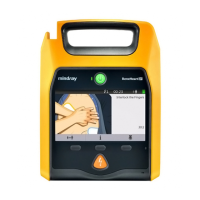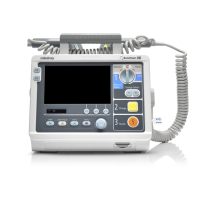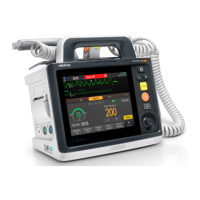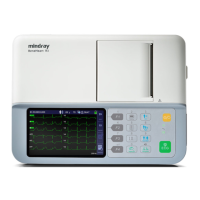What to do if Mindray BeneHeart D1 Medical Equipment warns that 'Pads expiring soon'?
- Aangela78Sep 23, 2025
If your Mindray Medical Equipment warns that 'Pads expiring soon', replace the pads timely.

What to do if Mindray BeneHeart D1 Medical Equipment warns that 'Pads expiring soon'?
If your Mindray Medical Equipment warns that 'Pads expiring soon', replace the pads timely.
What to do if Mindray BeneHeart D1 Medical Equipment turns off unexpectedly?
If your Mindray Medical Equipment turns off unexpectedly, it could be due to a depleted battery, in which case you should replace the battery. Alternatively, it may indicate a battery or equipment malfunction, which requires calling for service.
Why does Mindray BeneHeart D1 charge too slowly?
If your Mindray Medical Equipment is charging too slowly, the battery may be depleted, requiring a replacement. Alternatively, a battery or equipment malfunction might be the cause, in which case you should call for service.
How to enable alarm sound on Mindray BeneHeart D1 Medical Equipment?
If there is no alarm sound on your Mindray Medical Equipment, it could be because the audio alarm is disabled. To resolve this, select ?[Config.]?[Config. Edit]? enter the required password?[Alarm Setup]. Then set [Alm Volume] to [Low] or [High]. If this doesn't solve the problem, it may be due to an equipment malfunction, which requires calling for service.
What to do if Mindray BeneHeart D1 disarms automatically after charging?
If your Mindray Medical Equipment charges properly but disarms automatically, it could be due to the electrode pads being detached from the patient; ensure a good connection. Another possibility is that the electrode pads are damaged, in which case you should replace them. If neither of these solutions works, the equipment may have a malfunction, and you should call for service.
What to do if Mindray BeneHeart D1 indicates 'Low Battery'?
If your Mindray Medical Equipment indicates 'Low Battery', replace the battery.
What does 'Power Board Selftest Err' mean on Mindray Medical Equipment?
If your Mindray Medical Equipment displays 'Power Board Selftest Err', it indicates a system power failure. Restart the equipment.
What does 'Memory Error' mean on Mindray BeneHeart D1?
If your Mindray Medical Equipment displays a 'Memory Error', it means there was a memory read write failure or initialization error. Restart the equipment.
What to check if there are ECG issues with Mindray BeneHeart D1 Medical Equipment?
If you are experiencing ECG issues with your Mindray Medical Equipment, it may be because arrhythmia has occurred to the patient. Check the patient’s condition, and the pads, electrode, cables and leadwires.
How to reduce ECG noise on Mindray Medical Equipment?
If you're experiencing ECG noise with your Mindray Medical Equipment, it indicates that the ECG signal is noisy. Check for any possible sources of signal noise from the area around the cable and electrode, and check the patient for excessive motion.
| Device Type | Automated External Defibrillator (AED) |
|---|---|
| Display | LCD |
| Waveform | Biphasic Truncated Exponential (BTE) |
| Voice Prompts | Yes |
| CPR Guidance | Yes |
| CPR Feedback | Yes |
| Operating Temperature | 0 °C to 50 °C |
| Relative Humidity | 5% to 95% (non-condensing) |
| IP Rating | IP55 |
| Battery Type | Lithium-ion |
| Battery Life | 5 years |
| Energy Selection (Adult) | 150 J, 200 J |
| Energy Selection (Child) | 50 J, 70 J |
| Self-Test | Daily, weekly, monthly self-tests |
| Data Recording | Yes |
| Storage Temperature | -20 °C to 60 °C |
| Weight | 2.2 kg (including battery) |
| Altitude | 0 to 15, 000 feet (0 to 4, 575 meters) |
Lists specific conditions under which the warranty does not apply.
Provides contact details for the manufacturer and EC representative.
Explains the manual's purpose for safe operation and proper use of the product.
Identifies the target users of this operator's manual.
Clarifies that illustrations are examples and may not reflect exact setup.
Explains formatting and symbols used within the manual.
Defines danger, warning, caution, and note symbols for hazard communication.
Details hazards like high electrical energy, disassembly, flammable atmospheres, and defibrillation current.
Lists warnings for device integrity, power, patient monitoring, and accessory use.
Provides cautions regarding equipment disposal, interference, and handling.
Offers tips for placement, manual retention, features, and readiness for use.
Illustrates and explains common symbols found on the equipment and in the manual.
Describes the BeneHeart D1 as a portable AED, its configurations, and data management.
Specifies the intended use for Pro and Public configurations and qualified personnel.
Details when the AED mode should be used for unresponsive, non-breathing patients.
Explains manual defibrillation for VF/VT and synchronized cardioversion for AF.
Describes the ECG monitoring function for waveform and heart rate display.
Identifies the main unit components through front view diagrams.
Details the components visible on the front of the BeneHeart D1.
Identifies components visible on the side of the BeneHeart D1.
Details components visible on the rear of the BeneHeart D1.
Explains the display views for Pro and Public, alarm symbols, and alarm area.
Describes the symbols and their corresponding functions for the soft keys.
Details the installation requirements, including warnings and unpacking.
Guides on how to unpack and inspect the equipment and accessories for damage.
Specifies the environmental conditions necessary for proper equipment operation.
Provides step-by-step instructions for installing the battery.
Explains how to connect the electrode pads to the equipment.
Covers turning the equipment on and changing general settings.
Steps to power on the BeneHeart D1 equipment.
Explains how to access and modify general settings via the menu.
Describes how to set the system language and bilingual options.
Allows setting the default startup mode (AED or Manual) for Pro models.
Provides the procedure for safely turning off the equipment.
Explains how the equipment restores settings after power interruption.
Details steps after using the equipment to prepare it for the next use.
Classifies alarms into physiological and technical types.
Defines alarm levels (High, Medium, Low) based on severity.
Describes how alarms are indicated visually and audibly.
Details the different tone patterns used for various alarm levels.
Explains alarm message display, asterisk symbols, and background color coding.
Explains symbols indicating alarm sound status (paused or off).
Covers adjusting alarm volume and pausing/switching off alarm sounds.
Instructions for setting alarm volume to High, Med, Low, or Off.
Details how to temporarily silence alarm tones using the [Silence] softkey.
Explains how to disable alarm sounds and the resulting reminder tone.
Explains how to enable or disable the reminder tone.
Describes how technical alarms are cleared after using the [Silence] softkey.
Provides steps to follow when an alarm occurs.
Introduces AED mode, analysis, and guidance provided by the equipment.
Details critical safety measures for AED operation, including dangers and warnings.
Shows typical screen layouts for AED mode for Pro and Public versions.
Step-by-step guide for performing AED defibrillation.
Explains what happens when a shockable rhythm is detected.
Details the procedure when no shock is advised.
Explains CPR instructions and mode during AED operation.
Describes the CPR metronome feature for guiding compressions and ventilations.
Explains how to configure and use the sound recording function.
Details how to access and configure AED settings.
Introduces manual defibrillation mode and its procedures.
Details critical safety precautions for manual defibrillation.
Shows the typical screen display for manual defibrillation mode.
Step-by-step guide for performing manual defibrillation.
Explains how to synchronize cardioversion with the ECG R-wave.
Detailed steps for performing synchronized cardioversion.
Instructions for delivering subsequent synchronized shocks.
Procedure to switch off the synchronized cardioversion function.
Explains ECG measurement, display, and availability on Pro models.
Provides safety guidelines for ECG monitoring, including electrode sites and pacemakers.
Describes the ECG waveform and heart rate display.
Details skin preparation and connection of ECG monitoring equipment.
Steps for skin preparation and electrode placement for ECG monitoring.
Instructions for preparing skin and placing pads for ECG monitoring.
Covers changing ECG settings like lead type, gain, and filter mode.
How to select the lead type for ECG monitoring.
Adjusting the ECG waveform gain for better visibility.
Selecting between AHA and IEC standards for ECG lead placement.
How to change the filter mode for ECG monitoring.
Provides information on patient condition and arrhythmia alarms.
Details various arrhythmia events, their descriptions, and categories.
Enables or disables arrhythmia analysis for lethal events or all events.
Adjusting threshold settings for triggering arrhythmia alarms.
Explains when arrhythmia relearning is initiated automatically.
Explains patient data recording and export capabilities.
Lists recommended USB flash memory brands and models.
Provides instructions for exporting data to a USB flash memory.
Explains how to view, change, restore, and export configuration settings.
Instructions to view the current system configuration.
Information about the password required for configuration access.
Steps to access the configuration management menu and dialog box.
Guide to restore all current settings to factory defaults.
Lists all configurable items within the [Config. Edit] menu.
Details settings available in the General Setup menu.
Lists configurable items within the AED Setup menu.
Details manual defibrillation setup options for Pro models.
Lists configurable items within the CPR Setup menu.
Details ECG setup options for Pro models.
Lists alarm setup options for Pro models.
Details options available in the Test Setup menu.
Lists network configuration options.
Options for managing configuration files (default, import, export).
Introduces rechargeable and disposable batteries and on-screen status indicators.
Describes alarms for low battery, aged battery, and battery errors.
Explains the low battery alarm, prompts, and actions to take.
Details the alarm for a battery reaching its aged limit.
Describes the alarm for a battery failure.
Step-by-step instructions for replacing the battery.
Information on charging rechargeable batteries using the specified charger.
Guidelines for storing batteries to maintain their life expectancy.
Instructions for discarding and recycling batteries according to regulations.
General rules for keeping equipment clean and undamaged.
Details recommended cleaning agents and steps for cleaning the equipment.
Recommends disinfectants and notes on disinfection for the equipment.
Outlines recommended tests and inspections for equipment readiness.
Provides a schedule for routine checks, daily, weekly, and monthly tests.
Describes the self-tests the equipment performs.
Describes the immediate test performed when the equipment is turned on.
Explains the test that runs continuously during equipment operation.
Details the automatic test performed when a battery is inserted.
Describes the auto test performed at a configured time.
Instructions for performing a user test on the equipment.
Refers to appendix for details on electrical safety inspection.
Lists common symptoms, possible causes, and corrective actions.
Details important physiological and technical alarm messages.
Lists physiological alarms, levels, causes, and solutions for Pro models.
Lists technical alarms, their cause, solution, and clearing indicators.
Lists ECG accessories including trunk cables and lead sets.
Details therapy accessories such as multifunction electrode pads.
Lists miscellaneous items like batteries and charger stations.
Details general specifications like shock protection, size, weight, and display.
Covers defibrillation modes, waveform, electrodes, and energy selection.
Details ECG input, gain, paper speed, and bandwidth specifications.
Provides specifications for rechargeable and disposable batteries and run times.
Details alarm levels, categories, and parameter setting capabilities.
Covers data storage, waveform storage, event recording, and data export.
Details wireless network standards and operating frequency.
Specifies operating and storage temperature, humidity, and barometric pressure.
Details compliance for RF emissions and the electromagnetic environment.
Specifies compliance levels for electrostatic discharge and magnetic fields.
Provides guidance for conducted and radiated RF immunity.
Details acceptance criteria for inspecting the power cord plug and body.
Covers visual and contextual inspection of enclosure and accessories.
Ensures manufacturer and warning labels are present and legible.
Specifies limits for patient leakage current under various conditions.
Details the test for mains voltage applied to part leakage.
Specifies limits for patient auxiliary current measurements.
Lists common units of measurement used in the manual.
Defines common symbols used in the manual.
Defines abbreviations and acronyms used in the manual.











